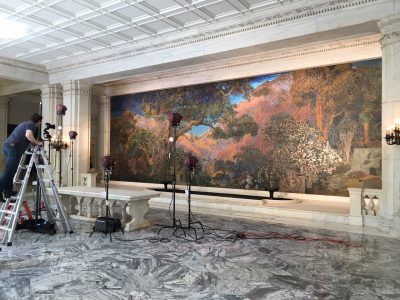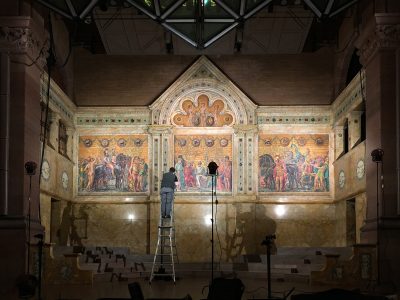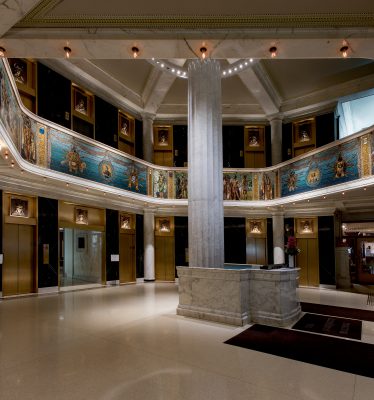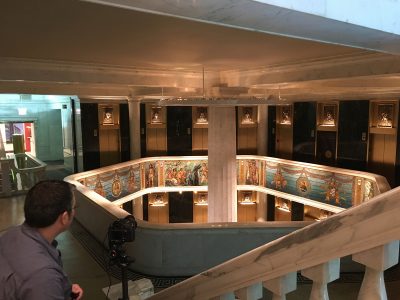One of the challenges of organizing Tiffany’s Glass Mosaics was that many of Tiffany’s mosaics are located in their original architectural settings, or in situ, and cannot be removed to loan to an exhibition. Curators Kelly Conway and Lindsy Parrott and the Museum’s photography team saw this as an opportunity to use photography to immerse visitors in some of these large-scale mosaics.

Photography department manager Andrew
Fortune getting ready to photograph the
Tiffany mosaics at the First Presbyterian
Church in Bath, N.Y.
“Glass mosaics are difficult to photograph well in any circumstances, but this project presented additional challenges,” explains Andrew Fortune, Collections Photography Department Manager at the Museum. “Most of the large mosaic panels are high above floor level, existing lighting is insufficient, available power is limited, and almost all the sites are open to the public.”
But CMoG’s photography team accepted this challenge and hit the road, taking their cameras and lighting equipment to photograph carefully selected installations throughout the Northeast. The team photographed churches and other buildings across New York State—Rochester, Binghamton, Auburn, Clifton Springs, Troy, and New York City.
They also photographed several public murals, including The Curtis Center and The Dream Garden in Philadelphia, Alexander Hall at Princeton University in New Jersey, and Macy’s (formerly Marshall Field & Company) in Chicago. “The Dream Garden mosaic in Philadelphia is located very close to Independence Hall and large tour groups, especially kids from Summer camps, would fill the entire lobby space of the Curtis Building without warning,” says Fortune.
- Andrew Fortune photographs The Dream Garden at The Curtis Center in Philadelphia.
- Photographing the Tiffany mosaic in Alexander Hall at Princeton University.
Shooting the mosaics in the Marquette Building in Chicago posed multiple challenges for the photography team. “The mosaic is a frieze on a balcony that surrounds a massive central column in a very busy lobby with 10 elevators in near constant use.” Fortune explained that, “The only way to capture the frieze was from the second floor balcony itself, but the central column blocked the view of each panel. We had to capture the panels in sections and then stitch the images together afterward.”
- View of the Tiffany mosaic at the Marquette Building from the first floor.
- Photographing the mosaics at the Marquette Building from the second floor.
While coordinating the photography was quite an undertaking, involving staff from all areas of the Museum, the groundbreaking presentation of images in the Tiffany’s Glass Mosaics publication and the exhibition’s “Mosaic Theater” allows visitors to view some of these works in ways they’d never be able to even if they visited them on site.

Tiffany’s Glass Mosaics is on view at The Corning Museum of Glass through January 7, 2018. Learn more about the exhibition.





